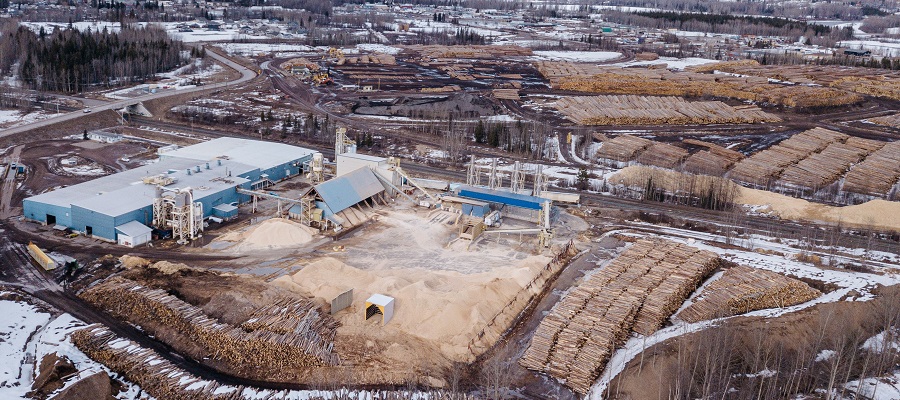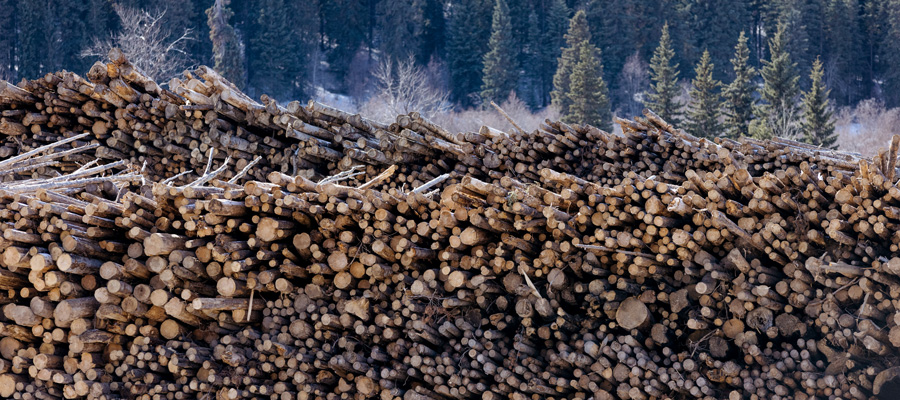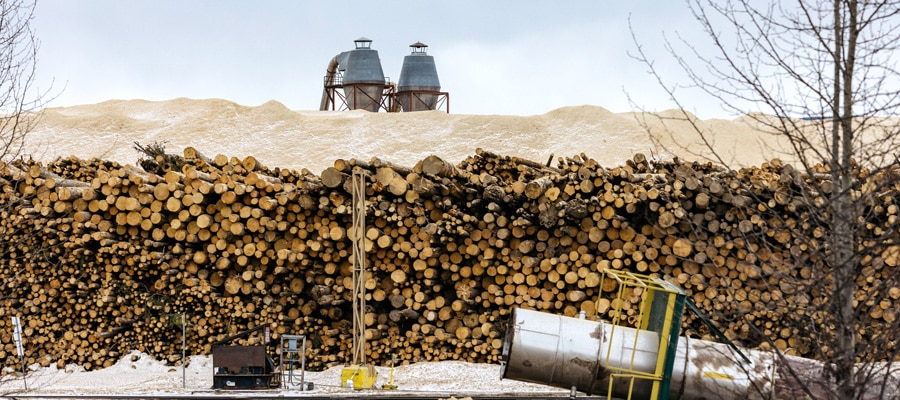Promises of cleaner air up in smoke

Calls for BC environment minister to suspend pellet mill permit
Every year, the air in the Bulkley Valley community of Smithers becomes hazardous to human health as thousands of fires known as slash burns are deliberately set at logging sites.
The contaminated air can stay trapped in the valley’s airshed for extended periods as the slash piles smolder, resulting in local residents breathing in fine particulate matter that can damage hearts and lungs.
So when a company proposed to build a wood pellet mill in town and claimed the mill would help reduce all that smoke, local residents paid attention.
Northern Engineered Wood Products or NewPro claimed that if it got the green light to build a pellet mill on the site of a particleboard plant it had previously operated in town the result would be an immediate and consequential drop in slash-burning operations.
Instead of the branches and shattered portions of tree trunks left behind at logging operations being burned, the company told the public, the local town council, the provincial government and others that the material would be trucked to town to make pellets.
But what was promised and what was delivered are two very different things.
Local resident and former longtime provincial Ministry of Environment employee Len Vanderstar says the moment the pellet mill opened in 2018, the primary source material used to make the pellets came from tens of thousands of logs taken from the forest, along with wood chips and sawdust generated at the sawmill next door.
“Hoodwinked”
Meanwhile, the open-burning of logging slash piles that the company claimed would be utilized as source material continued much as before.
“We were hoodwinked,” Vanderstar says, adding that it wasn’t just members of his community that were misled but also Smithers town council and provincial government officials who had to make the call on whether to issue the company an amended permit allowing it to build the new facility. What was promised and what was delivered are two very different things.
In a letter to George Heyman, minister of environment and climate change policy, Vanderstar notes that since the pellet mill commenced operations in 2018, it “has used whole logs as one of its most important sources for wood fibre and there has been no demonstrable reduction in slash-burning, which continues to be a matter of serious concern for public health and safety.”
The letter, co-signed by Michelle Connolly of Prince George-based Conservation North, goes on to note that “with still over 20,000 slash piles being burned every fall within the Bulkley-Nechako airshed where three wood pellet plants currently operate, persistent smoke continues to affect human health, quality of life and economics.”
An FOI request documents misleading claims
Vanderstar has lived in the Bulkley Valley since 1989 and worked as a habitat protection biologist with the provincial government for 25 years before retiring in 2018. He is a director of Bulkley Valley Clean Air Now, a group opposed to slash-burning.
Short of an outright ban of the practice, the group wants the provincial government to apply BC’s carbon tax to all the emissions associated with slash-burning. Minister Heyman was instructed to do so when he received his mandate letter from then-premier John Horgan in 2017 but has yet to act.
Meanwhile, the pellet industry has received millions of tax dollars in subsidies from the Forest Enhancement Society, a creation of the provincial government. The money has paid for the delivery of logs from logging sites to pellet mills and pulp mills, but has not made a dent in slash-burning activities, Vanderstar says.
Documents recently obtained by Vanderstar through a Freedom of Information (FOI) request filed with his former employer show that NewPro applied to the BC government in 2015 to amend an existing permit, which would allow it to build a wood pellet mill in Smithers on the same site where it previously operated a particleboard plant. It shut that plant down in 2014.
The amendment required the approval of the environment ministry. As part of its application process, the company had to inform the public about its intentions and hold public meetings. The pellet industry has received millions of tax dollars in subsidies.
At one point the company said it would consume so much slash that it would result in 1,200 fewer fires being deliberately set at logging sites each year. It went on to claim that the benefits for the local airshed would be equivalent to 3,700 residents stopping burning wood in their fireplaces and stoves to heat their homes.
The reference to residential firewood burning was something the company knew members of the public could relate to because wood smoke from home fires is detrimental to air quality in Smithers and many other rural communities and is also highly visible.
In another document, the company claimed that the pellet mill would take “approximately 50,000 bone dry tonnes of logging slash from the forest, thus eliminating it from being inefficiently burned in open piles within the local air shed.”
And in yet another document, the company indicated it would transport an industrial “grinder” into logged forests and use the grinder to “reduce the size of the wood debris.” After grinding up branches and shattered sections of tree trunks, the wood would then be loaded onto trucks to be delivered to the pellet mill, rather than being burned on site as slash.
“The more material we use out of the bush the better we actually make it in the valley than what it was before,” NewPro’s vice-president Dave Jacobs claimed at the time.
Such claims had the desired effect, particularly with Smithers’ town council, which voted unanimously in favour of the proposed plant.
“The new pellet plant is being proposed in a severely compromised airshed where particulate air pollution consistently exceeds provincial guidelines. This air quality concern presents a credible health risk for local residents and undermines the quality of life that makes Smithers and the Bulkley Valley such a desirable place to live,” Smithers’ then-mayor Taylor Bacharach wrote in a letter sent to the provincial environment ministry at the end of July 2015.
The valley’s poor air quality was also top of mind for local physicians and public health officials.
Where there’s smoke there’s disease
In a letter to Smithers town council, Northern Health said the most significant source of particulate matter in the local airshed was “debris burning” by logging companies.
The letter, signed by Northern Health’s chief medical health officer Dr. Sanda Allison and medical health officer Dr. Raina Fumerton, noted “there are no known ‘safe’ levels for particulate matter” in the air and that the finer particulate matter that is associated with smoke, known as PM 2.5 (particulate that is 2.5 microns or smaller in diameter) “is the most problematic.”
The duo noted that even at low levels in the air, PM 2.5 is associated with respiratory and cardiovascular diseases and is designated as a Group 1 carcinogen.
“Recent evidence suggests that ambient PM 2.5 air pollution has an important mortality burden, even in regions with relatively low PM 2.5 concentrations,” they wrote.
Another letter included in the FOI package was clearly written by a local physician, but the name had been redacted. The letter writer was later confirmed to be Dr. Biz Bastien, who lived and worked as a physician in Smithers for more than 30 years beginning in the early 1980s.
Early on in her time in Smithers, Bastien says it was obvious that something was not right.
“Every second kid we we’re seeing was coming in with asthma attacks,” Bastien recalls.
She was one of about a dozen doctors—which meant pretty much all the doctors in the Smithers area—to form the Physicians Environmental Concerns Committee.
The committee immediately dove into research, contacting local pharmacists to try to understand what they were seeing, working with the hospital to better understand patterns of Emergency Room admissions and researching how Smithers’ air stacked up with that of other communities.
The committee soon learned that air quality in Smithers in the mid ‘80s was on par with heavily industrialized Pittsburgh, where the air was considered so bad it was like exposing every adult and child to the equivalent of smoking a pack a day of cigarettes.
At the time, Bastien says the Bulkley Valley’s air was badly compromised by the presence of beehive burners that were incinerating the huge volume of wood waste generated at local sawmills. That practice eventually ended, but not until 2005, decades after such facilities had been shut down in the US. Every second kid we we’re seeing was coming in with asthma attacks.
Bastien’s July 2015 letter noted that physicians in town knew that cases of asthma and chronic obstructive pulmonary disease (COPD) were higher in the region than the provincial average and that local pharmacies were prescribing bronchodilators and inhalable steroids in numbers above the provincial norm.
Bastien went on to note that ongoing medical studies showed that more than just respiratory diseases are associated with elevated PM 2.5 levels in the air.
She noted that local doctors had analyzed a year’s worth of data on Emergency Room visits to the local hospital fully expecting to see a correlation between bad air events in the valley and people showing up in the emergency room with asthma or COPD.
“To our surprise, the statistics showed that the most significant diagnosis was cardiac arrythmias in males under the age of 40!” Bastien wrote in the letter. “This corroborated the new information in the [medical] literature.”
Bastien went on to note that particulate matter and volatile emissions in the airshed may be behind even more troubling health issues.
“We are seeing lung cancers in young people in their 40s with no family history of same, and no history of smoking. A frequent question I get from local residents is ‘Why is there so much cancer in this valley?’ It is a no brainer with the medical knowledge that we now have to say that the air quality in this valley is certainly one input into this situation.”
Speaking from her new home in the Pemberton Valley, Bastien says that what she saw during her decades of practice in northwest BC convinced her that where there’s smoke there’s disease.
“It’s toxic as hell,” she said.
Good riddance
Vanderstar says that when NewPro closed the particleboard plant, many in town thought the closure was a good thing.
“We weren’t ever thrilled about having the particleboard plant here in town,” he said. “It was a problem. They used formaldehyde-based binders for adhering the boards’ components together. And when you dry formaldehyde-based binders in the plant, they release volatile organic compounds (VOC) and there’s no regulation for VOC emissions in BC, except in the city of Vancouver. This stuff is not safe. Formaldehyde emissions from composite wood product manufacturing can trigger asthmatic reactions with possible links to cancers.” We are seeing lung cancers in young people in their 40s with no family history of same.
At first glance, Vanderstar says it may appear that the pellet plant made a difference. Ten years of air quality data he analyzed from 2012 to 2022 shows that PM 2.5 levels actually dropped by an average of 20% between the time the pellet mill commenced operations in 2018 to 2022.
But a closer look at the same data shows the drop was virtually unchanged from months during which slash was burned and months where it was not.
“Thus, any improvement of air quality is not associated with the claim of a reduction in slash burning, but is likely associated with better compliance with industrial venting, woodstove replacement programs and higher efficiency woodstoves, and general warming of our winters with less inversions,” Vanderstar said in an email.
Drax comes to town
While NewPro obtained the amended permit allowing it to proceed with its pellet mill plans, another company eventually built, operated and owned the pellet mill.
When the new plant opened in fall 2018, it became one of seven owned or co-owned by Pinnacle Renewable Energy—later purchased by Drax—giving the company a stake in half the province’s pellet mills. More importantly, given the size of many of its mills, Pinnacle controlled nearly two thirds (63%) of the more than 2.5 million tonnes of pellets produced annually in BC.
Many of those pellets are produced in communities that are often subject to foul air each fall from slash-burning operations. That includes the communities of Smithers and Houston, both in the Bulkley Valley and Burns Lake, less than an hour’s drive to the southeast of Houston.
In addition to the three mills being in fairly close proximity, they are also located beside railway lines that transport hundreds of thousands of tonnes of wood pellets to Prince Rupert, where they are loaded into the holds of ocean freighters.
Many of those tankers travel down the western seaboard to the Panama Canal, eventually making their way to the United Kingdom where they are destined for burning at a massive thermal electricity plant in North Yorkshire owned by the Drax Group.
In April 2021, Drax announced it had completed the purchase of Pinnacle. With the purchase, the company claimed it had secured nearly five million tonnes of “sustainable biomass” annually from across Western Canada and the southeast United States.
But many take issue with the company’s claims that its operations have little or no impact on BC forests or those elsewhere in North America.
“Contrary to claims that they use ‘residual’ wood including logging slash and sawmill waste, pellet makers like Drax use hundreds of thousands of logs per year. Those logs all come from BC’s rapidly disappearing primary forests, which partly explains why we are in an ecological crisis,” says Conservation North Director Michelle Connolly.
Drax under spotlight
Late last year, Conservation North released a video showing active logging of an old-growth forest in north central BC. The forest, which had been identified as a candidate for deferral from logging because of its ecological value, was turned over to Drax under a licence issued by BC Timber Sales, an arm of the provincial government.
Shortly before that video was released, the BBC TV investigative documentary show Panorama aired a documentary showing large numbers of logs being chipped directly to make pellets at Drax operations in Burns Lake and near Quesnel. Pellet makers like Drax use hundreds of thousands of logs per year.
The airing of the BBC documentary proved particularly problematic for Drax, which is now under investigation by Ofgem—the United Kingdom’s Office of Gas and Electricity Markets—for burning pellets, which may have originated from old-growth forests in British Columbia, in its powerplant. Currently, Drax receives hundreds of millions of pounds annually in “green energy” subsidies from the UK government, subsidies that reportedly may be in jeopardy as a result of the Ofgem probe.
More logging, more slash burning
According to data analyzed recently by the BC Office of the Canadian Centre for Policy Alternatives, as many as 100,000 cubic metres of logs—not slash—were delivered to the Smithers pellet mill owned by Drax in recent years. And more than double that volume was delivered in a single year to Drax’s Burns Lake facility.
Vanderstar notes that many of those logs may be characterized by Drax as “slash” or “low quality logs” or “pulp logs.” But whatever the descriptor, they come from forests that are being cleared of all their trees and where slash piles continue to be burned every fall.
Vanderstar says many of those logging operations now occur at much higher elevations than they did in years gone by. Because trees at higher elevations are smaller than those at lower elevations, more land must be cleared to get the same volume of wood out.
The more land cleared, the more slash burned.
Vanderstar says he hopes his letter to the minister will prompt the government to suspend the permit for the Smithers pellet mill, and that Drax will be compelled to report exactly how many logs it is running through the plant and exactly how many slash piles have allegedly been prevented from being burned as a result of its operations.
He also thinks regulations should be changed to make it clear that if a company misrepresents what it intends to do during a permitting process, it runs the risk of having that permit canceled.
“We want the Environmental Management Act amended so that it is clear that permits will be canceled outright if companies make misleading claims in support of their applications,” Vanderstar says.
Joseph Aquino, director of sustainability at Drax Group Canada, declined to respond to several questions regarding the company’s Smithers pellet mill operation, slash pile burning and the mill’s wood supply.
Topics: Climate change & energy policy, Environment, resources & sustainability


